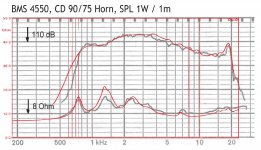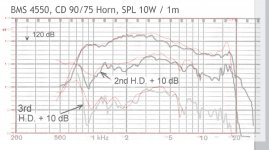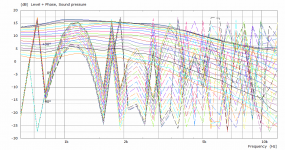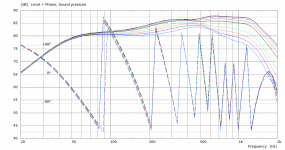0.1 mm more of linear excursion and -145 Hz lower fs (600!) for more than four times the price of the smaller Tymphany.
On another note: after working out a good asymmetric waveguide for optimized driver spacing at a crossover frequency of around 1.2 kHz, at 800 Hz, it would now be a totally different ratio, at 0.65 lambda. Huh
So if I understand you correclty @weltersys, you assume that the smaller Tymphany can work down to this frequency as a HiFi driver without constraints other than SPL is more limited? Because the smaller is a steal, I would hesitate, while the bigger costs me more considerations.
On another note: after working out a good asymmetric waveguide for optimized driver spacing at a crossover frequency of around 1.2 kHz, at 800 Hz, it would now be a totally different ratio, at 0.65 lambda. Huh
So if I understand you correclty @weltersys, you assume that the smaller Tymphany can work down to this frequency as a HiFi driver without constraints other than SPL is more limited? Because the smaller is a steal, I would hesitate, while the bigger costs me more considerations.
Looks like a very competent driver. How do their prices compare to say B&C?
At TLHP the CMP50 is 158 Euros vs 141 Euros for the DE500 excluding tax.Looks like a very competent driver. How do their prices compare to say B&C?
I know a DE250 can do 800 Hz, I'm only reluctant to say that the smaller DFM-2535R00 can do it as well without some kind of checking - it has only a 1.4" diaphragm and based on the lumped element models I tried there was always a frequency below which the excursion rised very rapidly. Can a DFM-2535R00 do 800 Hz? That was the particular question. Given your response, it probably can.
It has also a bigger version (1.75" diaphragm + 3x the nominal x-max): https://en.toutlehautparleur.com/lo...rless-dfm-2544r00-08-8-ohm-1-inch-throat.html
I would stay away from using it for a project because it's hard to get. It's not clear to me if they'll start making them again, but here's what I got the last time I tried to buy four:
"Regretfully, your ordered item, 264-1420 (Peerless DFM-2535R00-08 1" Compression Horn Driver 2/4-Bolt), has become discontinued and unavailable. I apologize for the inconvenience. Your credit card will not be charged for the 3 of 4 that were unable to ship."
I've heard it in Bill Waslo's "Small Syns" and I think it sounds fairly good. I like the ring radiators a little better.
This was discussed before:
No, it is not discontinued, but probably not available for a few months. I got the information directly from Tymphany itself.
For the tweeters, however, it is due to the current supply problems.
I know the German distribution of Tymphany very well and therefore know that at the moment there are delivery problems for very many parts, because the raw materials are only available at very high prices. Unfortunately, nobody knows when this situation will change.
The HF10AK has a driver dip at about 2K that shows up in every measurement which will dominate that area whatever you do.If somebody knows how to get rid of the 1.8kHz pinch indirectivity - please share.
I've tried to vary every parameter with no success.
Worth a lot - thanks!!
"My" BMS 5530 is not there but it seems that BMS just tried to do a small 4550 with the 5530? Would have been nice to see the Kartesian in this kind of comparison.
5530 in red below... the new employee (?) at BMS didn't bother to change the sound card to 96 ksps for the 5530.... :-/ lame!
The 18 Sound NSD1095N I haven't really checked out...
//
"My" BMS 5530 is not there but it seems that BMS just tried to do a small 4550 with the 5530? Would have been nice to see the Kartesian in this kind of comparison.
5530 in red below... the new employee (?) at BMS didn't bother to change the sound card to 96 ksps for the 5530.... :-/ lame!
The 18 Sound NSD1095N I haven't really checked out...
//
Attachments
Last edited:
Regarding NSD1095N, beware that it falls quite rapidly at HF - it may or may not present a problem, depending on a crossover used (if you hear that high).
Here with a basic filter:


Here with a basic filter:
No, that's not my design. I think the low DI shown is a consequence of having the polars for the front hemisphere only, i.e. it's not strictly correct. The real DI will be higher, IMO.
- I think it was this design. The woofer should be a 9" or 10":


- I think it was this design. The woofer should be a 9" or 10":
Last edited:
BTW, the R-OSSE profile continues naturally past the mouth edge if you let it. Just a curiosity, I don't think it has any special significance:
https://www.desmos.com/calculator/ujfimmy0sd


https://www.desmos.com/calculator/ujfimmy0sd
How about printing it? 😀
What is the matter with phase extraction from VCAS? Fluid said there was an LE script needed. How would LE be recalculated and can it be done "by hand", like in a calculator as in that of VCAD? Why I ask is, that my latest, lucky discovery only works due to the location and dimension of the vertical nulls. With the data extracted from VCAS, the nulls just take take away the excess energy which the widening of the pattern creates and therefore balance the listening window with SP and DI further down. If I could, I'd like to verify this before printing.
What is the matter with phase extraction from VCAS? Fluid said there was an LE script needed. How would LE be recalculated and can it be done "by hand", like in a calculator as in that of VCAD? Why I ask is, that my latest, lucky discovery only works due to the location and dimension of the vertical nulls. With the data extracted from VCAS, the nulls just take take away the excess energy which the widening of the pattern creates and therefore balance the listening window with SP and DI further down. If I could, I'd like to verify this before printing.
The spl is a complex value in vacs (at least in the VIPs file). There is some phase in that. I looked at it once, I think it also has the 'accumulated phase' to the point where the spl is determined. Haven't thought about it further...
I also plan to look at the phase extraction closely, it should be possible. I only don't see what has a LE model to do with it. Both phase and amplitude are defined at the source (with or without an LE model, it shouldn't matter). A phase everywhere else should be simply related to the phase of the source, plus the propagation delay (which can be compensated afterwards - globally). A believe a complete set of complex polars can be exported for a further work in a crossover simulator, with the correct relative phasing needed.
Last edited:
What indicates us the "correct relative phasing"? So I can export everything from VCAS, phase information has integrity but needs to be shifted by a currently unknown amount, correct?
Using an LE script that gives driver rolloffs at either end makes for cleaner more realistic phase traces in VACS, it might not be necessary but it seems a good idea to me. Removing the propagation delay would still be necessary.
Attachments
OK, but the point is that it shouldn't really matter. The final result should be the same either way, i.e. it's not necessary (and it certainly should not do any harm either). You show two different frequency ranges.
- On the pictures above, the connecting lines are of course rubbish but the individual points should still be correct - that is what's important.
- On the pictures above, the connecting lines are of course rubbish but the individual points should still be correct - that is what's important.
Last edited:
- Home
- Loudspeakers
- Multi-Way
- Acoustic Horn Design – The Easy Way (Ath4)



